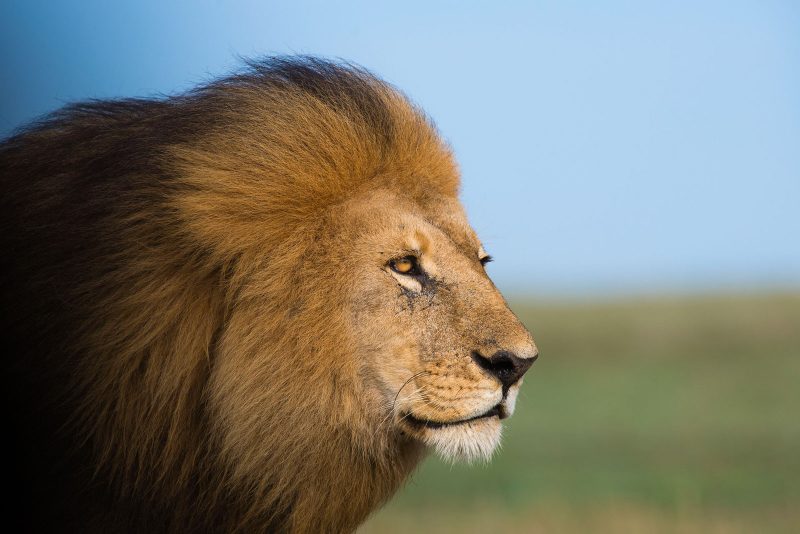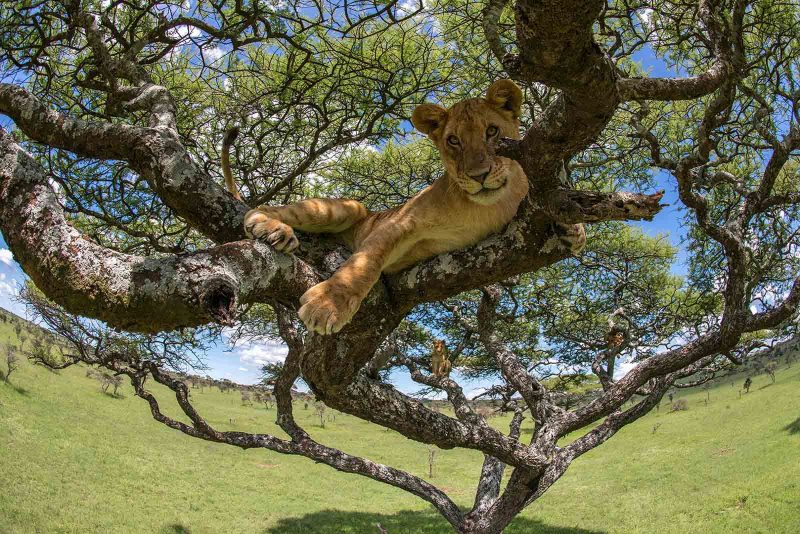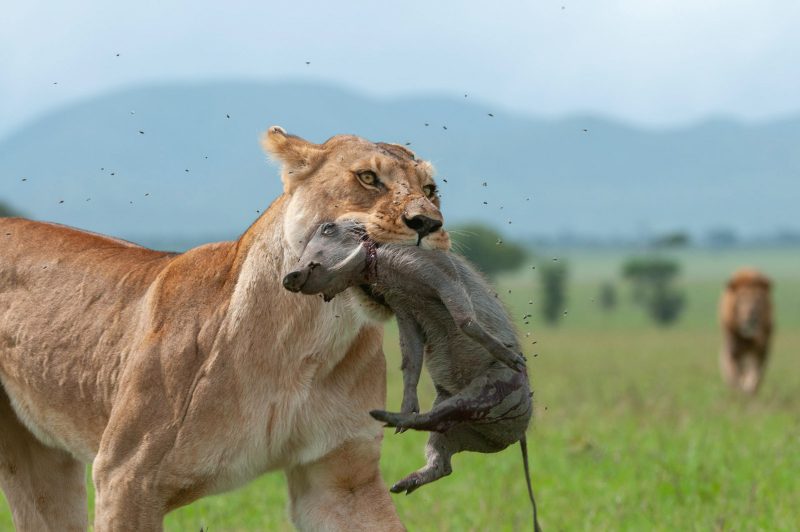Unique Photographs Offer Insights Into the Secret Lives of Serengeti Lions

After having travelled by bicycle for a year and a half in South America, I got an e-mail that would change my life completely.
It was a simple question; “Do you want to come and work for the Serengeti Lion Project?”.



I thought about it for about a second, and then replied “Yes!”. Though I had to sign up for at least a year, I ended up staying for five years.
The lions of the Serengeti
The Serengeti Lion Project started in 1966 and is one of the longest studies of any wild animal. A large part of what we know about lion ecology today originates from this project.
I was employed by the University of Minnesota and Professor Craig Packer to collect demographic data.

Essentially, my job was to track and follow some 25+ prides every week, taking notes on things like where they were, what they were doing, what they were eating, their belly size (as a measurement of hunting success) and anything else of interest.
The Serengeti National Park is a UNESCO World Heritage site and one of the absolute best places for wildlife viewing. It is home to the great wildebeest migration where about 1.3 million wildebeest circle the ecosystem together with hundreds of thousands of zebras and gazelles.

The wildebeest also move outside of the Serengeti National Park, into the surrounding reserves, including the Maasai Mara in Kenya.
This area used by the migration, called the Serengeti Ecosystem, is very large – it’s about the size of Belgium or Maryland.
Finding new photography angles
Knowing I was about to live in one of the best places on earth for wildlife photography, I bought myself a Nikon 200-400mm/f4 lens. Being an amateur photographer, it was a bit above my budget, but I thought of it as an investment in my future.

I found the range of the lens very useful as the animals there are used to cars and getting close is generally not a problem. I even found myself using my 70-200mm/f2.8 quite often when the 200-400mm range was too much.
But the combo that I got the most unique angles and photos with was the 14-24mm/f2.8 and a monopod.

It is not always recommended, for obvious reasons, to step out of the car to get that low-angle shot of a lion. So, I simply put my camera on the monopod with a wide-angle lens on and stuck it out of the car window, close to the ground.
I triggered the camera with either a remote cord or just set the camera on interval shooting, one shot per second.

The fun thing about this was that some of the inquisitive lions often came for a closer look. Other times they completely ignored me, which was also great for getting shots with natural behavior.
Working for the lion project, I wa granted a special permit that allowed me to drive off-road and do other things that tourists visiting the park are simply not allowed to do.

Moreover, with time, I learned to read the body language of the lions and the lions got used to me and trusted me. I really wouldn’t recommend anyone else to try these techniques.
A visit from Nick Nichols, one of National Geographic’s top photographers, and his team would soon lead me to capturing even more creative angles of the Serengetti’s lions.

The group came out to the Serengeti to document a story on lions. I became their point of contact and the one to put what they saw into context.; I even introduced them to the lion pride Vumbi, who they would follow for nine months.
This pride included the now legendary males C-Boy and Hildur (also known as Bob and Ziggy).
Once a week I would stay at their camp, learning about photography and reciprocating with lion knowledge and other advice. We became good friends.

When they left, they gave me a five meter microphone boom, just because it was such a hassle to bring it on a flight, even in its shortest state.
This boom became a nice tool for me. I now esentially had a five meter monopod that could reach much further out of the car. I could now also reach high up in the trees, getting unique lion shots. I don’t think I ever saw anyone else getting similar angles.
Again, i must stress that you really don’t try this at home – at least not with lions.

I sometimes stood on the roof of my car reaching up into the trees and this was only possible because of my mutual trust wth the lions and the fact that I could read their body language and facial expressions so well through my extensive time spent with them.
Lions do climb trees, but not very well, and not all lions climb. Typically, Lake Manyara NP and Queen Elizabeth NP both advertise themselves as the only places to see tree-climbing lions.
But I’d say you are more likely to see tree-climbing lions in central Serengeti, near the Seronera river, especially in the wet season.

Tree-climbing lions are not a different species from normal lions. They are just lions that have developed a local tree-climbing culture, often in combination with easy-to-climb trees in the area.
But let’s be fair, though they can climb, they possess no climbing skills comparable to those of leopards.
While leopards are known to even hunt in trees, lions mostly use horizontal branches for resting, and once it’s time to go down, they often look extremely clumsy and seem to regret ever getting up there.
Photography and scientific research
I came to Serengeti hoping to get stunning and unique photos of lions. I initially saw my camera equipment as just a part of a side hobby I could do while collecting data on the lions. But it soon became clear to me it was an excellent tool for research.

All lions had to be identified individually, and this is done by looking at the positioning of their whisker spots, comparable to our fingerprints.
Back in the day, before digital cameras, this was done through binoculars and taking notes with pen and paper; a sometimes patience testing and tedious affair.
With a digital camera and a good lens, I could take a photo and then look at the whisker spots on screen, even if a lion only lifted its head out of the tall grass for a second,. I had about 300 lions to keep track of and my camera made this task much easier.
My camera turned out to be a great tool for documenting interesting and rarely-seen behaviors.

Being out in the field every day, I was bound to see behaviors that had not yet been documented.
One such behavior that Prof. Packer had seen in datasets was that females in prides that neighbored other prides with a large male coalition seemed to suffer higher mortality.
He predicted that the females in a pride with many males would encourage them to kill rival females in nearby prides and in that way reduce competition, but no one had actually ever seen this to confirm it was true.
One day I witnessed this very behavior!
Two different prides were close to each other. One pride had two males with them while the other had none.
The males themselves seemed unbothered by the presence of the other pride.
So, the females started the chase, but I could tell they weren’t trying their best. They were just starting the chase so that the males would join and finish it. And that is exactly what happened.

I couldn’t take photos of the chase as I was struggling to keep driving the 4×4 car on rough terrain with no tracks and lots of bushes. I only managed to get some shots from a distance of the final parts of the attack.
It wasn’t easy to observe, but viewing the events through a lens with a mission to document things made it somewhat easier.
They were no beauty shots or even spectacular shots in themselves. But they proved a theory, and in doing so hold scientific value.
The role of photography in conservation
As a wildlife photographer, it is greatly satisfying to know that your images are used for sicence. Better still is when your photos are used to protect nature and animals.

It is clear that one of the best ways to slow down global warming is to stop the destruction of nature, especially those areas with intact (or close to intact) ecosystems and with high biodiversity, and I am proud that my images of the Serengeti lions are being used to help protect the Serengeti.
BBC once published one of my lion photos with a quote from Sir David Attenborough himself; “The visual is always more powerful than words”.

In my experience this is very true. Photography can be such a powerful tool in science and to raise awareness for pressing issues.
A photo might be what draws that extra bit of attention to make someone read a text with an important message.
I believe that that photos have the power to create a greater love and awe for nature, making people more likely to want to protect it, something that is more important than ever and crucial to our survival.





